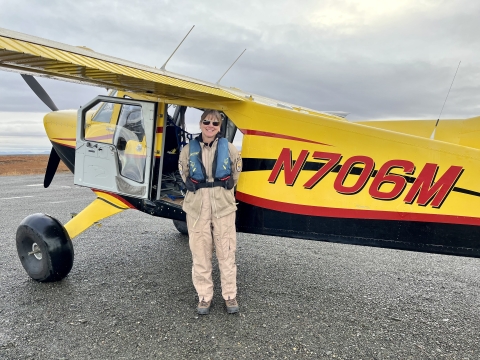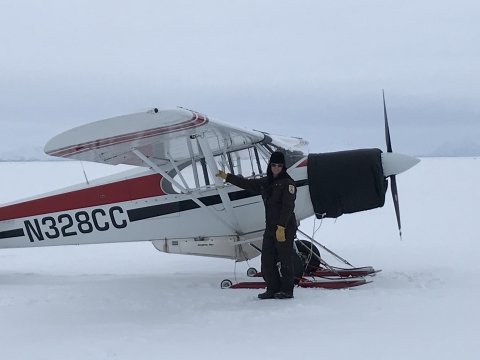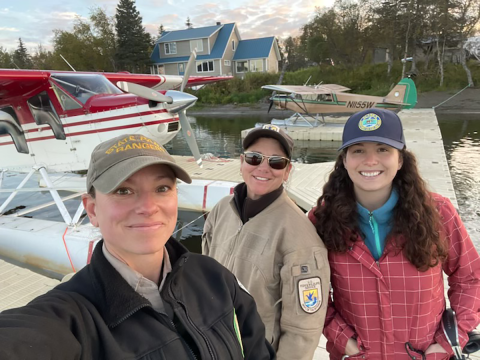In Alaska, the U.S. Fish & Wildlife Service employs a small army of dedicated and passionate staff with a large spectrum of roots. Some were born and raised in Alaska. Others have come from around the world. Regardless, some stay to do a job they feel is important enough to spend a lifetime doing. Pilot/Biologist Kara Hilwig tells us about her time flying for National Wildlife Refuges in Alaska and the great experiences she has in her day-to-day job.
What do you do for U.S. Fish and Wildlife Service?
I'm the pilot/biologist for Togiak National Wildlife Refuge. As a pilot/biologist for a National Wildlife Refuge, I have one of the most exciting jobs in the world, I think. I'm involved in all aspects of the refuge from our education components to our biology, to water quality, to any of our cooperative projects as well. I'm involved in all aspects of the biology program, including moose and caribou captures, as well as calving and salmon surveys. A pilot/biologist working for the National Wildlife Refuge System is a person who essentially enables everybody to get out on the refuge. So in Togiak refuge, there are essentially no roads that access the refuge. So the only way you get in there is by airplane, snow machine, or boat. So I'm the airplane driver.
The river systems are essentially the highways, for people and animals to kind of get through the refuge, many of which people enjoy doing float trips and fishing. We do patrols and things like that, too. So I'll use an airplane to drop people off for their float trips. So they can go do law enforcement, or bear hair snaring, or fisheries surveys. Whatever they need to do. It's always hard to pull up on the beach and kick these guys out with all their rafting equipment and not be able to go on the trip. I have to get back in the plane and fly home.
Did you grow up wanting to do this kind of work?
I was one of those kids that was always digging in the dirt and bringing home lots of interesting critters and letting 'em go in the house to see my mother's reaction and that was kind of just inherent. The biology was just inherent in me. I was always outside. I went through school and was always interested in the sciences and things like that and finally I graduated from high school and took an aptitude test. I didn't recall this until just a few years ago, but the aptitude test said that I should be a microbiologist or a pilot. Piloting was far from anything our family or anything I had been exposed to, and so that just didn't even seem like an option. So I ended up pursuing Wildlife and Fisheries Science at University of Arizona. I got my bachelor's there, and then went on to do my master's degree in biology.
How did you get into flying?
It seemed like everywhere I lived, I was always under the pattern of an airport so that the airplanes that were landing, were always overhead wherever my house was. So I was always looking up at those airplanes thinking, I bet I could do that. Then once I completed my master's degree, I decided, you know, I'm just going to do that. And I took flight lessons and basically gave myself the gift of flight lessons for completing my master's.
How did you get working in Alaska?
About 2010 I moved to Juneau and found myself working in a windowless office for eight hours a day looking through a microscope and I knew that wasn't the job for me. While I was there, I met a pilot with the U.S. Fish and Wildlife Service who really piqued my interest because he saw my airplane sitting at the airport, and we started having a discussion and he started talking about his job and I figured, okay, this is something I need to do. And so I was gunning for this job for about six years before I finally got it.
"I thought I had an idea of what this job was about and it is far more amazing than I ever anticipated."
How does your work as a biologist and pilot work together?
Everything in my background with fisheries biology has served me really well in the aviation world, because I did so much boat work and fisheries biology. And that directly translates to flying a float plane and being on the water in a float plane. And, you know, trying to keep a float plane upright in swift water. The airplane that I fly for work has skis, wheels, and floats associated with it. So I can fly different configurations as needed throughout the seasons. Also, it turns out one of the best things you can do when flying an airplane is to think like a fish, because air flows over the mountains like water over a streambed. Generally, fish like to stay out of the current, behind rocks or in eddy lines. This is NOT where you want to be as an airplane.
Because of the demands of piloting, the biology is maybe 20% or less of my time. And usually that just entails bringing data home and writing up a couple of reports and it's just because the flying part of it is so intense and the training requirements is pretty extensive. Most of my time is dedicated to the aviation part of it, preflighting, weather checking, flying and then maintaining U.S. Fish and Wildlife Service and FAA certifications.
What is it like flying for the National Wildlife Refuge System?
Flying as a Refuge Pilot is challenging. It demands, especially the cub flying, it demands building and maintaining technical flying skill. We're not just landing and airports and flying straight lines. We're low and slow counting fish in rivers or antler status on female caribou, tracking line-of-sight radio collars in mountainous areas, and providing top cover for the helicopter during capture operations. I also provide law enforcement support often using fighter pilot tactics to keep the aircraft from being seen or heard by people on the ground like keeping the aircraft near the sun so people can't easily look up and see us, or conversely, hitting them with our shadow so they know we are there. It has been a great learning experience figuring out how many ways aircraft are used to further the Refuge missions.
When I came on board, having a master's degree in biology and a pilot's license, and 500 hours to be able to fly for the service, you know, I was called the unicorn. You just don't exist. The aviation training is something that brings out all of your faults. It is so difficult in a lot of regards and so rewarding all at the same time. Operating equipment, there's certainly a propensity for folks to do well, if they enjoy that kind of thing. That's a very small portion of it. Because I'd say the majority of being successful in an airplane is the mental part of it. Where you have to be ahead of the airplane, you have to understand aerodynamics, you need to know if the engine bubbles a little bit, why did it do that, and you need to correct it right away. You need to know yourself. If you do get in a situation where you're in weather, and you can't see the ground, which is a very sickening feeling, you can't panic. If you do smell smoke in the cockpit, you can't panic and that's where the training comes in. When you're in a tense situation, you can't go all fliberty gidget and freak out. You got to maintain your head.
Every day, I go up in this airplane for work, and I cannot believe I'm getting paid to do this job. I fly across the refuge and it's the most beautiful wild place that I have ever seen in my entire life. You don't see fence lines, you don't see power lines, you don't see roads, you don't see any semblance of human disturbance across 4.7 million acres of land. It is unbelievable. It's very hard to describe to people who fly over the Lower 48 and they see a bunch of square grids laid across the ground with roads and pipelines and everything else. This refuge is just amazing. It's something that every person should try to see, but the only way they're gonna see it is by an airplane.
Do you stay busy as a pilot/biologist?
There is no downtime in refuge flying. In the wintertime we're doing captures and surveys. In the spring, we're doing telemetry to find collared animals to see how many babies they're having, and how they're surviving. Then in the summertime, we're doing float work with all the water quality where the fisheries work, invasive species invasive species
An invasive species is any plant or animal that has spread or been introduced into a new area where they are, or could, cause harm to the environment, economy, or human, animal, or plant health. Their unwelcome presence can destroy ecosystems and cost millions of dollars.
Learn more about invasive species work.
What is the most satisfying part of your position?
The most satisfying part of this job is being able to use the airplane as a tool to achieve really amazing, worthwhile projects that are towards the conservation of landscapes and critters on the refuge. Part of that concept of being a tool, it's me in the airplane and my passenger. All three of us have a job. When you fly a certain passenger time and time and time again, you become what I call a well-oiled machine where you know what's going on, you know what the next step is, and you can anticipate things. So the efficiency component has really improved and feeling like you and your passenger are a well oiled machine and feeling completely connected to the airplane. That is really, really rewarding for me.
What do you enjoy most?
I think what I enjoy most is flying over the landscape and reading the story that's written in the snow. So you can follow the moose tracks and follow the moose tracks to an individual moose or you can be flying along and see a little bit of blood in the snow. Then start following that and pretty soon you see a scene where wolves had chased a moose and done what wolves do, eat moose. You can see where it was probably a calf and then the cow left the area. So it's pretty interesting to, to read the story in the snow.
What is special about working in Alaska?
Working for the Fish and Wildlife Service and thinking about the refuge system down in the Lower 48, most of the refuges down there have some sort of hands-on management actions, like harvesting cornfields and leaving the stubble up for you know, winter forage for migrating waterfowl or actively removing something in order to promote another species. The refuge managers down there are actually I think I've seen the term "moving dirt" around to actively manage the landscape to promote conservation of various species. Alaska's lands and waters are largely intact, and they deserve every level of protection that we can possibly give them to conserve ecosystem processes and the subsistence users that rely on the critters that utilize the refuge. The grandeur of the refuges in Alaska is unmatched in the world in my opinion.
Adapted from episode 37 of the My Life, Wildlife Podcast!
In Alaska, the employees of the U.S. Fish and Wildlife Service are shared stewards of world renowned natural resources, and our nation's last true wild places. The lands and waters of this place we call home, nourish a vast and unique array of fish, wildlife, and people. Our hope is that each generation has the opportunity to live with live from discover, and enjoy the wildness of this odd inspiring land and the people who love and depend on it.
Follow us: Facebook Twitter Medium
Subscribe to My Life, Wildlife! On Apple or wherever you get your podcasts










